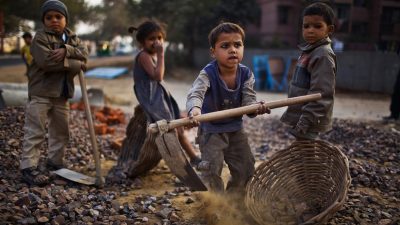Nearly 200 Million People Are “Modern Slaves” or Child Laborers

According to a report by the United Nations’ International Labour Organization, nearly 200 million people are victims of modern slavery or child labor around the globe. In 2016, 40.3 million men, women and children were victims of modern slavery. Nearly one in ten children, or 151.6 million people, are victims of child labor.
The report defines “modern slavery” as “the various forms of coercion prohibited in international instruments on human rights and labour standards.” This definition includes slavery, state-imposed forced labor, forced marriage, and human trafficking. One in four victims of forced labor are children, and 71 percent of total victims are female.
On any given day in 2016, approximately 16 million individuals were forced to work in the private sector. More than half of this labor involves the domestic, construction and manufacturing sectors. On average, victims are held for 20.5 months before escaping or being released.
The study also reports that 4.8 million people are victims of forced sexual exploitation. On average, victims are held for 23.4 months before escaping or being freed. The vast majority are women and girls, and children represent more than 20 percent of the victims.
By region, Africa has the highest rate of modern slavery, with 7.6 per 1,000 people. The rate is 6.1 per 1,000 people in Asia and the Pacific; 3.9 per 1,000 in Europe and Central Asia; 3.3 per 1,000 in the Arab states; and 1.9 per 1,000 in the Americas. Countries that are or have been recently ravaged by war experience higher levels of exploitation.
The ILO does not include in its definition of child labor those working in legal forms of employment. The definition used in the study includes work that is hazardous, demands too many hours, often deprives children of play and education, and puts their well being at risk. Despite the definition’s limited scope, the study still gives a picture of the staggering level of child labor around the globe.
According to the study, slightly less than half of children in child labor (72.5 million) are performing hazardous work that places their health, safety or moral development at risk. Over 19 million children between the ages of 5 and 11; over 16.3 million between 12 and 14; and 37 million between 15 and 17 are involved in hazardous work. The hours children are forced to work are also horrendous. Approximately 63.3 percent of children between 15 and 17 that are engaged in child labor are forced to work 43 hours or more per week.
Nearly a third of children involved in child labor are outside of the education system. Those who do attend school tend to perform more poorly than their nonworking peers. The time and energy spent working interferes with the ability to benefit fully from classroom hours and impedes study time outside the classroom.
As with modern slavery, a significant proportion of child labor is located in countries afflicted by conflict and disaster. Approximately 17 percent of children in war-torn countries are involved in child labor, nearly double the global average.
The countries included in the report as being affected by armed conflict include Afghanistan, the Central African Republic, Colombia, Iraq, Mali, Nigeria, the Philippines, South Sudan, Ukraine, Yemen and the Democratic Republic of the Congo. Other countries, including Syria and Libya, are not included as estimates were not available.
In Africa, one in five children is involved in child labor, making it the region where child labor is most concentrated, followed by Asia and the Pacific. However, child labor is not limited to low-income regions. In fact, over half of affected children live in lower middle- and upper middle-income countries, and 1.3 percent of children in high-income countries are child laborers.
While the percentage of children involved in child labor has fallen slightly from 2012 globally, it has actually increased in Sub-Saharan Africa.
The epidemic of slavery and child labor is one aspect of capitalist exploitation. The International Labour Organization estimates that $150 billion in profits are generated in the private sector each year from forced labor.
The issue is exacerbated in countries that are victims to neocolonial exploitation and imperialist conquest. A video released by CNN this week showed youth being auctioned off as farm laborers in Libya, a country devastated by the US-backed war launched by the Obama administration.
A 2016 investigation by Amnesty International revealed that children as young as seven are working in perilous conditions in the Democratic Republic of the Congo to mine cobalt that ends up in smartphones, cars and computers sold to millions across the world. The mines supply corporations such as Apple, Microsoft and Vodafone.
The United Nations and leaders of industrialized countries have only taken modest measures to tackle the issues of modern slavery and child labor. This epidemic is not a question of laws and reforms, but a consequence of capitalism.
Featured image is from Infinite Fire.

